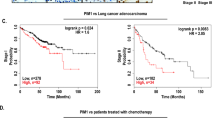Abstract
Apoptosis, a tightly controlled multi-step mechanism of cell death, is important for anti-cancer therapy-based elimination of tumor cells. However, this process is not always efficient. Small cell lung carcinoma (SCLC) and non-small cell lung carcinoma (NSCLC) cells display different susceptibility to undergo apoptosis induced by anticancer treatment. In contrast to SCLC, NSCLC cells are cross-resistant to a broad spectrum of apoptotic stimuli, including receptor stimulation, cytotoxic drugs and γ-radiation. Since resistance of tumor cells to treatment often accounts for the failure of traditional forms of cancer therapy, in the present study attempts to find a potent broad-range apoptosis inductor, which can kill therapy-resistant NSCLC cells were undertaken and the mechanism of apoptosis induction by this drug was investigated in detail. We found that staurosporine (STS) had cell killing effect on both types of lung carcinomas. Release of cytochrome c, activation of apical and effector caspases followed by cleavage of their nuclear substrates and morphological changes specific for apoptosis were observed in STS-treated cells. In contrast to treatment with radiation or chemotherapy drugs, STS induces mitochondrial dysfunction followed by translocation of AIF into the nuclei. These events preceded the activation of nuclear apoptosis. Thus, in lung carcinomas two cell death pathways, caspase-dependent and caspase-independent, coexist. In NSCLC cells, where the caspase-dependent pathway is less efficient, the triggering of an AIF-mediated caspase-independent mechanism circumvents the resistance of these cells to treatment.
This is a preview of subscription content, access via your institution
Access options
Subscribe to this journal
Receive 50 print issues and online access
$259.00 per year
only $5.18 per issue
Buy this article
- Purchase on Springer Link
- Instant access to full article PDF
Prices may be subject to local taxes which are calculated during checkout








Similar content being viewed by others
References
Amarante-Mendes GP, Finucane DM, Martin SJ, Cotter TG, Salvesen GS, Green DR . 1998 Cell Death Differ. 5: 298–306
Bergh J, Larsson E, Zech L, Nilsson K . 1982 Acta. Pathol. Microbiol. Immunol. Scand [A] 90: 14–158
Bergh J, Nilsson K, Ekman R, Giovanella B . 1985 Acta. Pathol. Microbiol. Immunol. Scand. [A] 93: 133–147
Caponigro F, French RC, Kaye SB . 1997 Anticancer Drugs 8: 26–33
Comis RL, Friedland DM, Good BC . 1998 Oncology 12: 44–50
Daugas E, Susin SA, Zamzami N, Ferri KF, Irinopoulou T, Larochette N, Prevost MC, Leber B, Andrews D, Penninger J, Kroemer G . 2000 FASEB J. 14: 729–739
Deas O, Dumont C, MacFarlane M, Rouleau M, Hebib C, Harper F, Hirsch F, Charpentier B, Cohen GM, Senik A . 1998 J. Immunol. 161: 3375–3383
Ekert PG, Silke J, Vaux DL . 1999 EMBO J. 18: 330–338
Galli G, Fratelli M . 1993 Exp. Cell Res. 204: 54–60
Germain M, Affar EB, D'Amours D, Dixit VM, Salvesen GS, Poirier GG . 1999 J. Biol. Chem. 274: 28379–28384
Gescher A . 2000 Crit. Rev. Oncol/Hematol. 34: 127–135
Han Z, Pantazis P, Lange TS, Wyche JH, Hendrickson EA . 2000 Cell Death Diff. 7: 521–530
Hengartner M . 2000 Nature 407: 770–776
Jarvis WD, Grant S . 1999 Invest. New Drugs 17: 227–240
Johnson VL, Ko SC, Holmstrom TH, Eriksson JE, Chow SC . 2000 J. Cell Sci. 113: 2941–2953
Josa N, Susin SA, Daugas E, Stanford WL, Cho SK, Li CY, Sasaki T, Elia AJ, Cheng HY, Ravagnan L, Ferri KF, Zamzami N, Wakeham A, Hakem R, Yoshida H, Kong YY, Mak TW, Zuniga-Pflucker JC, Kroemer G, Penninger JM . 2001 Nature 410: 549–554
Joseph B, Ekedahl J, Sirzén F, Lewensohn R, Zhivotovsky B . 1999 Biochem. Biophys. Res. Commun. 262: 381–387
Joseph B, Ekedahl J, Lewensohn R, Marchetti P, Formstecher P, Zhivotovsky B . 2001 Oncogene 20: 2877–2888
Joseph B, Lewensohn R, Zhivotovsky B . 2000 Ann. NY. Acad. Sci. 926: 204–216
Kluck R, Bossy-Wetzel E, Green D, Newmeyer D . 1997 Science 275: 1132–1136
Nicholson DW, Ali A, Thornberry NA, Vaillancourt JP, Ding CK, Gallant M, Gareau Y, Griffin PR, Labelle M, Lazebnik YA, Munday NA, Raju SM, Smulson ME, Yamin TT, Yu VL, Miller D . 1995 Nature 376: 37–43
Martinou JC, Green DR . 2001 Nat. Rev. Mol. Cell Biol. 2: 63–67
Owens Jr AH, Abeloff MD . 1985 Neoplasms of the lung Calabresi P, Schein PS, Rosenberg SA (eds) Medical Oncology Macmillan pp. 715–757
Schottenfeld D . 1996 Epidemiology of lung cancer Pass HI, Mitchel JB, Johnson D, Turrisi AT (eds) Lung cancer – principles and practice Lippincott-Raven Publ pp. 305–322
Sirzén F, Zhivotovsky B, Nilsson A, Bergh J, Lewensohn R . 1998 Lung Cancer 22: 1–13
Stennicke HR, Salvesen GS . 2000 Biochem. Biophys. Acta. 1477: 299–306
Stepczynska A, Lauber K, Engels IH, Janssen O, Kabelitz D, Wesselborg S, Schulze-Osthoff K . 2001 Oncogene 20: 1193–1201
Susin SA, Lorenzo HK, Zamzami N, Marzo I, Snow BE, Brothers GM, Mangion J, Jacotot E, Costantini P, Loeffler M, Larochette N, Goodlett DR, Aebersold R, Siderovski DP, Penninger JM, Kroemer G . 1999 Nature 397: 441–446
Tafani M, Minchenko DA, Serroni A, Farber JL . 2001 Cancer Res. 61: 2459–2466
Tewari M, Quan LT, O'Rourke K, Desnoyers S, Zeng Z, Beidler DR, Poirier GG, Salvesen GS, Dixit VM . 1995 Cell 81: 801–809
Travis WD, Linder J, Mackay B . 1996 Classification, histology, cytology and electron microscopy Pass HI, Mitchel JB, Johnson D, Turrisi AT (eds) Lung cancer – principles and practice Lippincott-Raven Publ pp. 361–395
Wei MC, Zong WX, Chang EHY, Lindsten T, Panoutsakopoulou V, Ross AJ, Roth KA, MacGregor GR, Thompson CB, Korsmeyer SJ . 2001 Science 292: 727–730
Zamzami N, Kroemer G . 2001 Nat. Rev. Mol. Cell Biol. 2: 67–71
Zamzami N, Marchetti P, Castedo M, Decaudin D, Macho A, Hirsch T, Susin S, Petit P, Mignotte B, Kroemer G . 1995 J. Exp. Med. 182: 367–377
Zhivotovsky B, Joseph B, Orrenius S . 1999a Exp. Cell Res. 248: 10–17
Zhivotovsky B, Samali A, Gahm A, Orrenius S . 1999b Cell Death Differ. 6: 644–651
Yang J, Liu X, Bhalla K, Kim C, Ibrado A, Cai J, Peng T, Jones D, Wang X . 1997 Science 275: 1129–1132
Acknowledgements
The authors are very grateful to Prof Sten Orrenius for support and Drs R Jemmerson and PH Kramer for providing antibodies. This work was supported by grants from the Swedish Cancer Society (3829-B98-03XAC), the Stockholm Cancer Society (98:119) and INSERM-MRC. B Joseph was supported by a Fellowship from Association de Recherche contre le Cancer.
Author information
Authors and Affiliations
Corresponding author
Rights and permissions
About this article
Cite this article
Joseph, B., Marchetti, P., Formstecher, P. et al. Mitochondrial dysfunction is an essential step for killing of non-small cell lung carcinomas resistant to conventional treatment. Oncogene 21, 65–77 (2002). https://doi.org/10.1038/sj.onc.1205018
Received:
Revised:
Accepted:
Published:
Issue Date:
DOI: https://doi.org/10.1038/sj.onc.1205018
Keywords
This article is cited by
-
Sulfur dioxide induces apoptosis via reactive oxygen species generation in rat cardiomyocytes
Environmental Science and Pollution Research (2019)
-
Inhibition of Ephrin B3-mediated survival signaling contributes to increased cell death response of non-small cell lung carcinoma cells after combined treatment with ionizing radiation and PKC 412
Cell Death & Disease (2013)
-
Detecting the effect of targeted anti-cancer medicines on single cancer cells using a poly-silicon wire ion sensor integrated with a confined sensitive window
Biomedical Microdevices (2012)
-
Caspase signalling controls microglia activation and neurotoxicity
Nature (2011)
-
Opposing effects of hMOF and SIRT1 on H4K16 acetylation and the sensitivity to the topoisomerase II inhibitor etoposide
Oncogene (2010)



